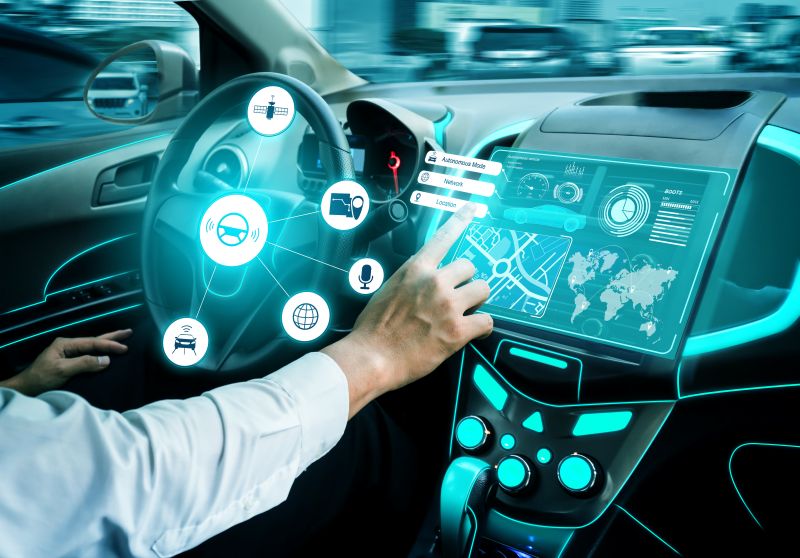Level 4 automated driving to be accompanied by a reimagining of key aspects of vehicle interiors like seating, heating, ventilation, and air conditioning (HVAC), safety, human-machine interface (HMI), heads-up display (HUD), and interior lighting.
Level 4 automated driving which involves hands-free, eyes-off, no driving activity will require a reimagining of various key aspects of the vehicle’s interiors, such as seating, heating, ventilation, and air conditioning (HVAC), safety, human-machine interface (HMI), heads-up display (HUD), and interior lighting. Across L4 passenger vehicles, autonomous shuttles, and robo-taxis, radically overhauled vehicle interiors will be accompanied by a slew of new comfort, convenience and safety features that support enhanced riding experiences.
Approaches to redesigning vehicle interiors for such L4 vehicles will vary in accordance with functional requirements: from more dedicated, purpose-built autonomous shuttles to the comparable interiors of robo-taxis and passenger vehicles. Automotive manufacturers will need to prioritize customization and personalization, while achieving differentiation through features that enhance comfort, convenience, entertainment, and safety. In parallel, they will need to ensure that interior solutions are flexible enough to accommodate operational efficiencies and differentiation for both rideshare and privately owned vehicles.
To learn more, please access Growth Opportunities in the Global Autonomous Vehicle Interiors Market, Global Advanced Driver Assistance Systems and Autonomous Driving Industry, Voice of the Customer: Health Wellness and Wellbeing Services in Cars, or contact sathyanarayanak@frost.com for information on a private briefing.
Advanced Technologies are Enabling Greater Comfort and Convenience
Advanced technologies, such as artificial intelligence (AI), augmented reality (AR), and self-learning are creating a plethora of new applications within vehicles’ cabins and cockpits that enhance occupant comfort and convenience. This is being reinforced by advances in connectivity technologies, automotive electronics, and software. These are enabling more smart features to be incorporated into vehicles.
Meanwhile, the move from ownership to usership models, including the use of robo-taxis and autonomous shuttles, will be accompanied by a shift in business models from a sales oriented to a services focused approach. Innovative business models anchored in collaboration will become more commonplace as new revenue opportunities linked to subscription-based services start gaining momentum.
Focus to be on Personalization, Enhanced Driving Experience
As opportunities burgeon, we expect the global autonomous vehicle interiors market to generate revenues of almost $464 million by 2030. To capitalize on emerging growth prospects, mobility providers should focus on personalization. For instance, personalized features, such as multi-zone HVAC systems and massaging seats, that are already offered in passenger vehicles, could be extended to robo-taxi services as well.
Vehicle occupant safety has been a major matter of concern in autonomous vehicles. Currently, most autonomous shuttles have only basic safety features such as seat belts and minimal provision for airbags. Not surprisingly then, safety will continue to be a priority for passengers using autonomous shuttles and robo-taxis.
On the one hand, this means OEMs and mobility providers must focus on ensuring occupant safety whether through seat belts integrated into the seats or the frame or through more novel features like cocoon airbags and seatbelt airbags. On the other hand, the lack of a driver in the conventional sense means there is freedom to experiment with interior design whether through flexible seating layouts or through seats that swivel. Indeed, it will be interesting to see how the combination of novel safety features with non-traditional seating arrangements evolves.
To comfort, convenience and safety can be added engagement & entertainment. The prospect of hands-free, eyes-off implies passengers in robo-taxis and autonomous shuttles can divert time and attention spent on traditional driving tasks to other activities. In turn, this implies the need to think of new, more meaningful ways to engage with and entertain vehicle occupants. Robo-taxis could, for example, come equipped with individual screens with customizable entertainment systems. Or multimedia screens could provide live information about the ride in autonomous shuttles. In time, technologies like AR would enhance the user experience even as sound bubbles and virtual privacy barriers would enable passengers to work while on-the-go.
With inputs from Amrita Shetty, Senior Manager, Communications & Content – Mobility




